We have just been treated to a goal fest, one of the best editions of Derby d’Italia in recent times – a 4-4 draw between Juventus and Inter Milan.
Prior to this fixture, Juve had not conceded a single goal from open play in Serie A this season – a seriously impressive run to kick off their campaign under Thiago Motta’s coaching style.
Reigning champions Inter, however, who won Italy’s top prize last season with a massive 19-point gap between themselves and second-placed AC Milan, were able to put an end to Juve’s formidable defensive record.
Amazingly, thanks to two penalties and a goal from a corner, just one of Inter’s four goals came from open play.
This tactical analysis will look at some of the key tactics deployed in this match.
We will discuss Inter’s off-the-ball activity, including their mid-block and aggressive counter-pressing under Simone Inzaghi’s tactics.
We will also provide an analysis of Juve’s attacking threat in wide areas and their possession progression to bypass the Inter midfield in certain areas.
The aim of this analysis is not to directly dissect the eight goals in this fixture or to explain why the game ended up being an eight-goal thriller but to explore some of the underlying tactical tones that helped shape the match’s outcome.
Juventus Vs Inter Lineups
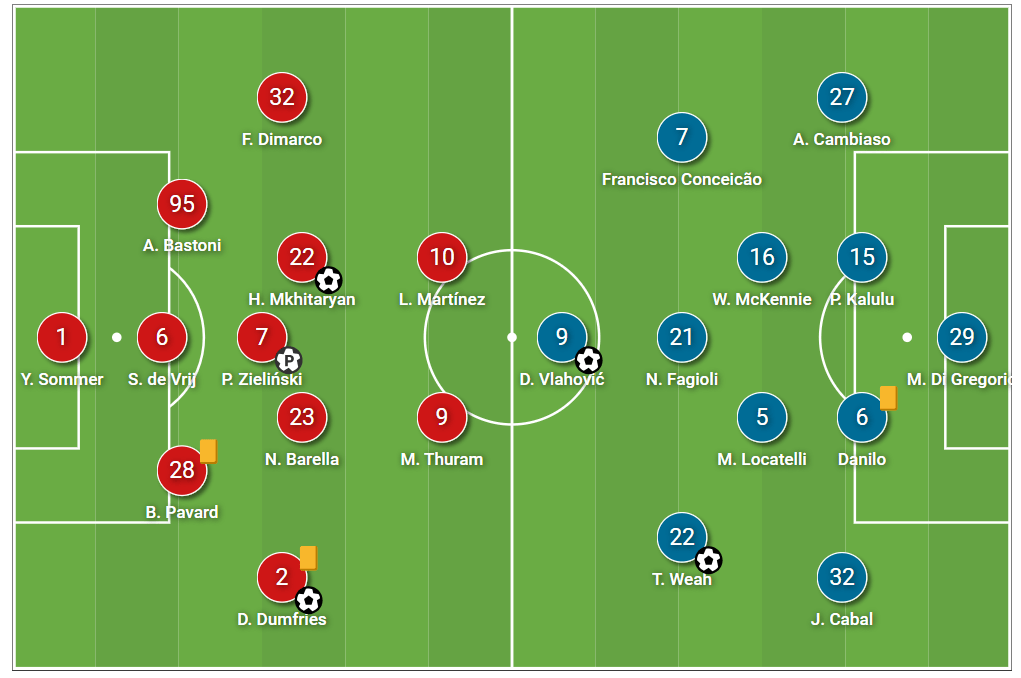
Neither team felt the need to alter their preferred formations for this one—it could be argued that Inter opted for a 5-3-2 rather than a 3-5-2 that aimed to limit Juve’s wide impact with a slightly more defensive presence, but the choice of personnel in the wing-back roles was more or less the same as what we’ve seen from Simone Inzaghi’s formation.
Davide Frattesi dropped to the bench to allow for the presence of Piotr Zieliński alongside a couple of familiar names in midfield, while Denzel Dumfries came in at right wing-back.
Meanwhile, Juve’s lineup changed a number of times after their 1-0 midweek defeat to VfB Stuttgart in the UEFA Champions League.
Michele Di Gregorio returned in between the sticks after missing the Stuttgart game, while Andrea Cambiaso reclaimed his position at right back.
Manuel Locatelli also returned to the starting lineup in midfield, while Khéphren Thuram and Kenan Yıldız were both dropped to the bench but did come on to help Motta’s side fight back from 4-2 down, with the latter player scoring twice in the final 20 minutes of the game.
Inter’s Aggressive Mid-Block Vs Juventus
Both sides posted PPDA numbers that were considerably higher than their usual register, indicating a slightly more reserved approach from both teams when out of possession.
However, Inter showed aggression that was triggered at certain moments and in certain areas—counter-pressing and making recoveries in high areas were essential parts of their game plan.
Inter Milan High Regains Map
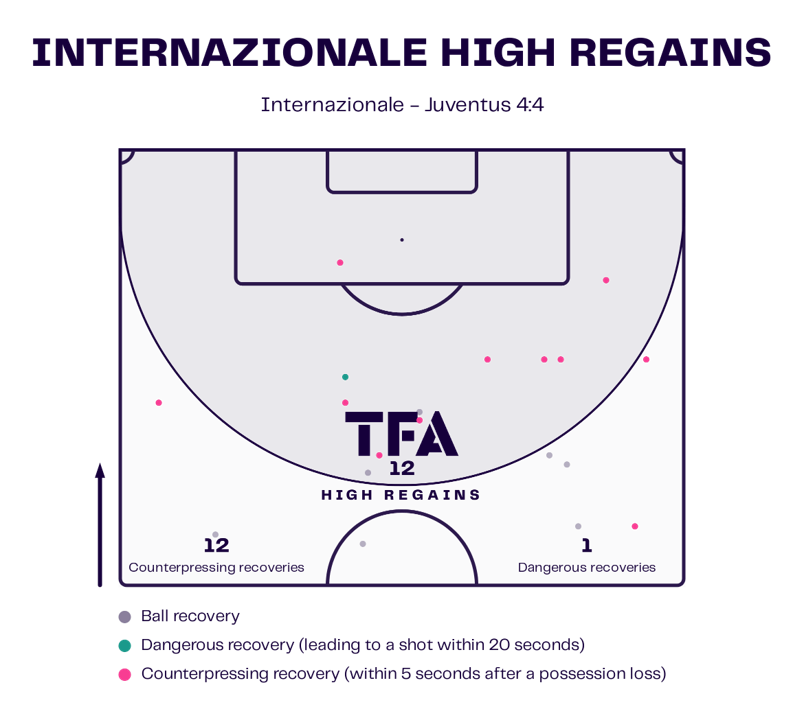
Figure 2 paints a picture of Inter’s actions when Juve had the ball—while Simone Inzaghi’s team was happy to sit in a mid-block during general possession periods, they were confident in their ability to execute counter-pressing manoeuvres in the right areas.
Many of these counter-pressing recoveries occurred down Inter’s right flank, Juve’s left—perhaps just a coincidence, but Inter also posed more of an attacking threat down that same flank.
According to our data, Inter made nine fewer ball recoveries than their opponents in this match, but they did make more high recoveries (12 in total), and most of them were the result of a counter-press.
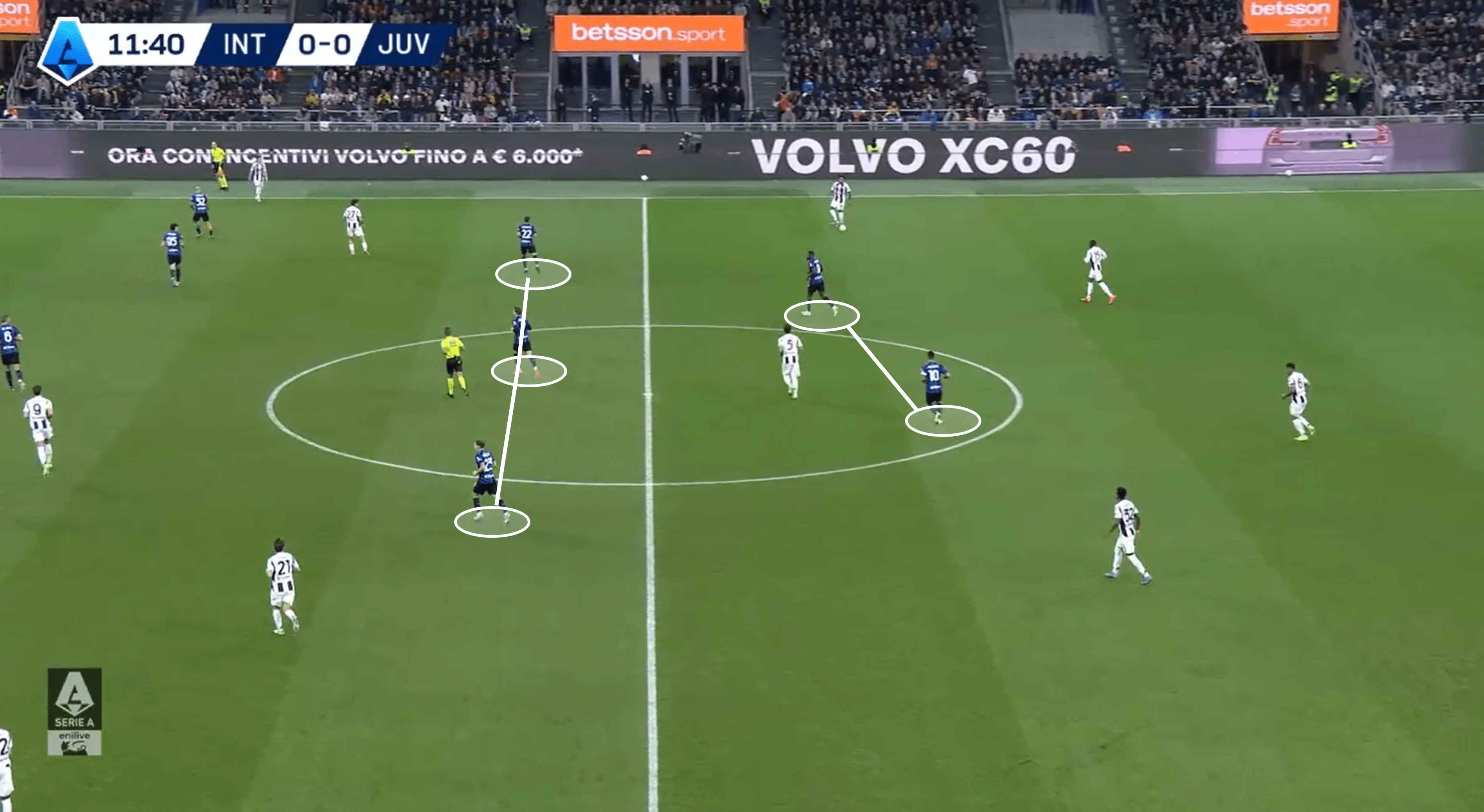
Look no further than Figure 3 to get an idea of Inter’s use of a mid-block in their 5-3-2 system.
Notice how the forwards show no interest in closing the ball down at this moment.
Instead, they show more interest in remaining close to each other and close enough to the midfield three to help them limit Juventus’ chances of playing through the centre.
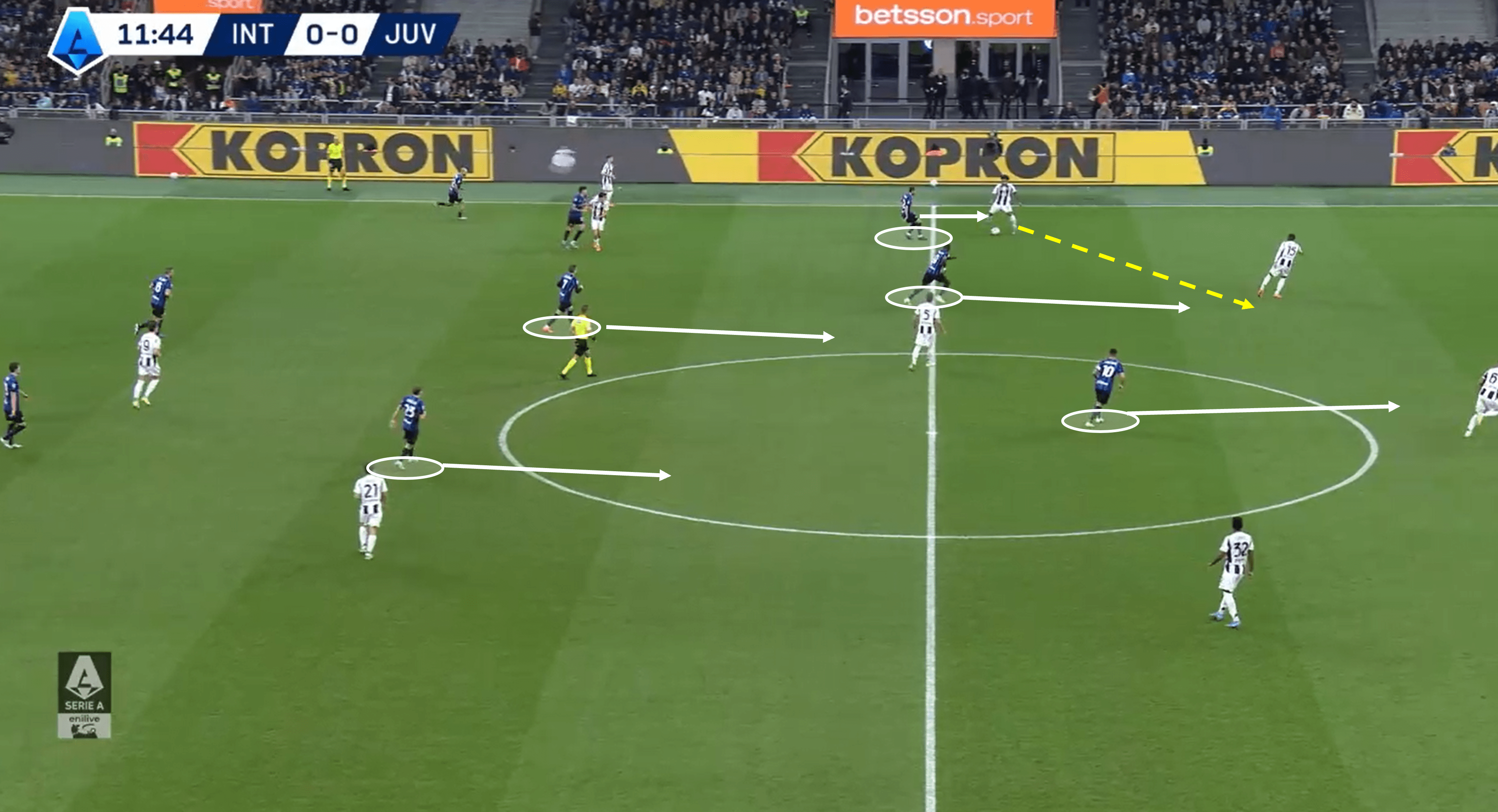
However, as we touched on earlier, Inter did have a tendency to inject some intensity and aggression into their defensive approach, as seen in Figure 4 above.
A backwards pass and a lack of forward movement from Juventus were pressing triggers for Inter, and as a unit of five, the forwards and midfield all showed that intensity to unsettle the opposition.
With immediate pressure on the ball and the next likely recipient (and even the one after) being closed down by forwards Marcus Thuram and Lautaro Martínez, the remaining central midfielders bolted forward to support that pressure, giving Juventus no chance of successfully overcoming that initial press.
As a result, Juve were forced to clear the ball long, handing possession to Inter.
Juventus’ Wide Danger Vs Inter Milan
Inter attempted more crosses in this match, but Juve had a higher cross-accuracy rate.
They also consistently tried to hurt Inter via the flanks and showed some quality in doing so.
Much of Juventus’s attacking threat came from wide areas—they attempted eight crosses, five of which found their target.
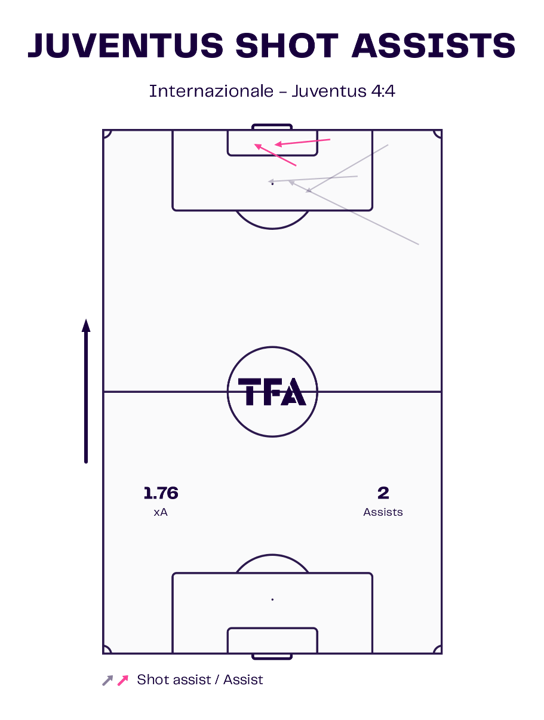
We spoke of Juve’s threat down the right flank earlier, and Figure 5 provides more evidence of it.
Any pass/cross that led to a Juve shot in this match came from the right side of the pitch (or went from right to left, at least), and as we’ll see soon, their crossing danger from that same flank was also high.
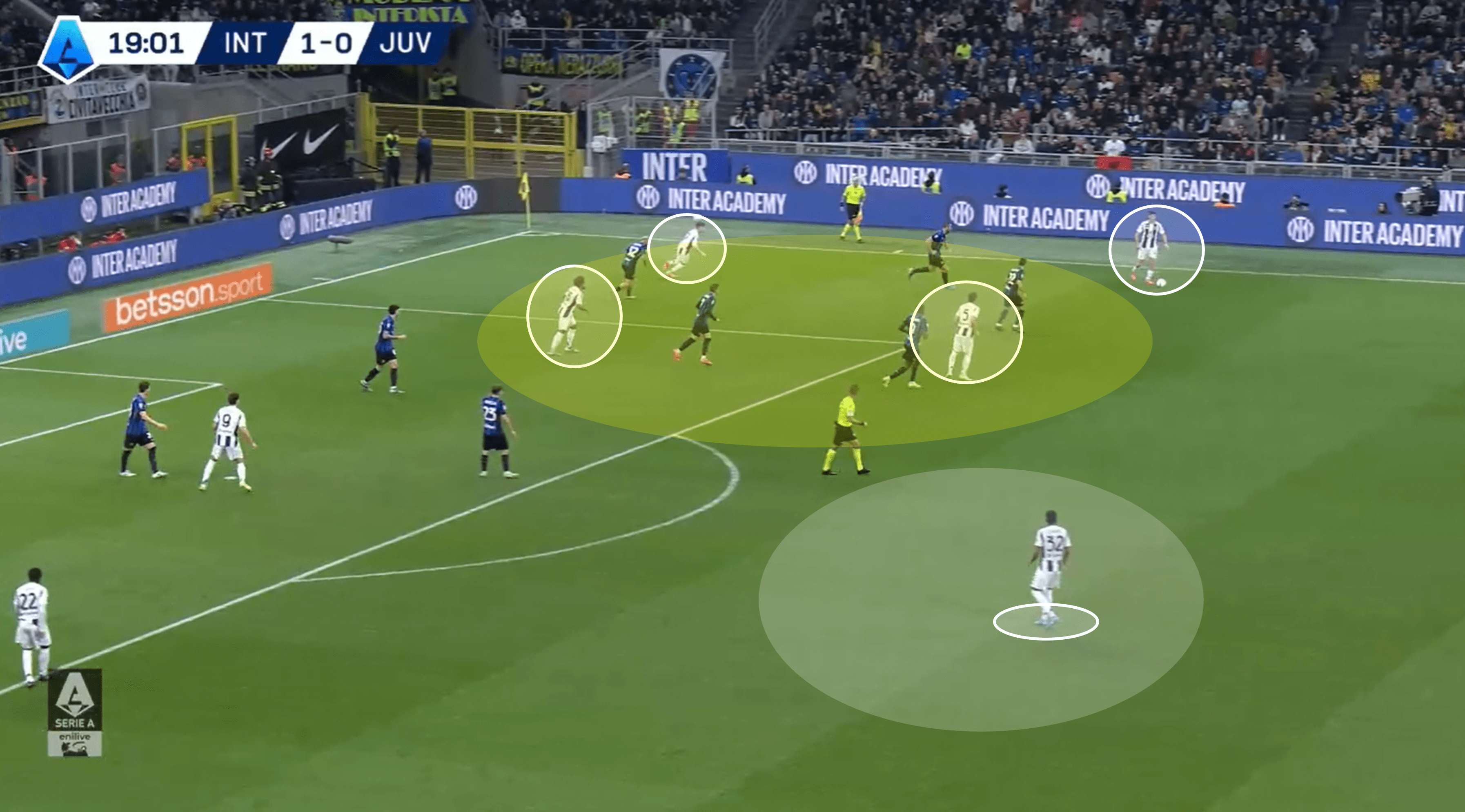
Overloading wide areas was an interesting part of Thiago Motta’s tactics in this fixture.
This attacking method was deployed in several scenarios, including when trying to penetrate Inter’s defence and get the ball into a dangerous area, as you see in Figure 6.
Four Juve players are situated on that right flank, and the shape/positioning of that presence is no coincidence—the two narrower players are there for two key reasons: they could be potential passing options if Juve looked to execute a passing combination and also drag some Inter shirts into that wide area, freeing up space elsewhere.
In this case, Juve were looking to exploit the latter.
A pass from the busy wide area into a quiet central midfield area shifted this attack into the next gear, with left-back-turned-creator Juan Cabal receiving the ball in that quiet central midfield zone.
Subsequently, Cabal found a delightful lofted through the pass over the Inter defence into the feet of Weston McKennie, who cushioned the pass down to Dušan Vlahovič to tap home for the first Juventus equaliser of the night.
Juventus Crossing Zones
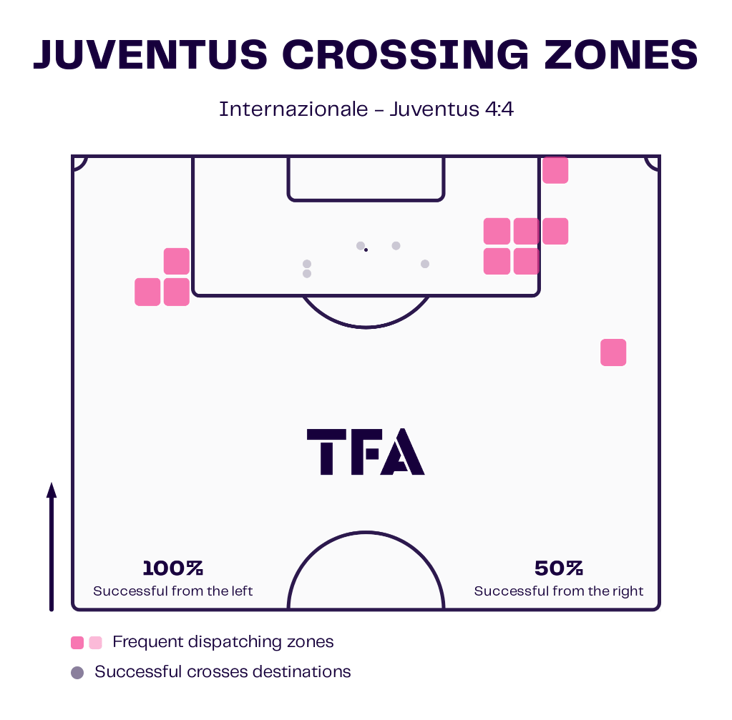
Juve’s crossing presence was felt more often from their right flank than the left, but they were effective when called upon from the latter side, as Figure 7 shows.
However, part of what made them so dangerous down the right flank was Francisco Conceição, who was often able to cause problems for Inter down that side, including getting into dangerous crossing positions.
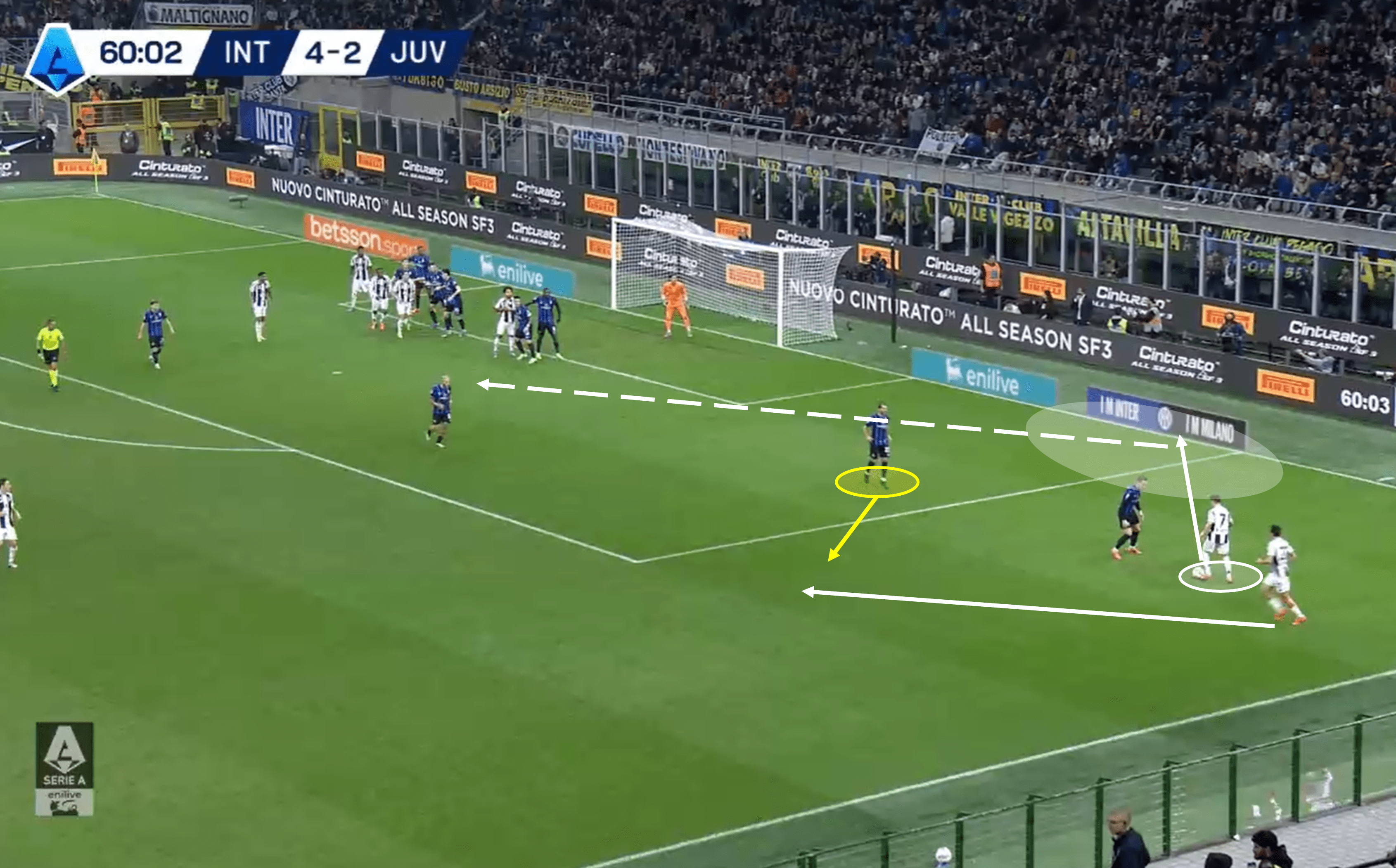
Figure 8 shows us exactly what we just spoke of – Conceição’s attacking threat from wide areas.
Using his teammate’s movement as a decoy to drag the second defender away, Conceição had successfully created a pure 1v1 situation.
His agility and footwork, combined with his pace, make for a deadly cocktail that is difficult for many defenders to swallow.
Conceição darted past his man toward the byline and showed no hesitation in firing in a low cross toward the penalty spot.
Actions like this, taking the ball from a relatively non-threatening area to create a goalscoring opportunity, are the mark of an effective winger.
Juventus Progressing Possession
As we have established, Inter’s midfield liked to be narrow in this tie as they aimed to limit Juventus’ central threat.
This led to Juve having to adapt Thiago Motta’s in-possession tactics slightly to make progress up the pitch.
Data shows that Motta’s team made more passes to the final third and more progressive passes than Inter, which indicates that Juve were working on playing against this particular tactical setup from Inzaghi.
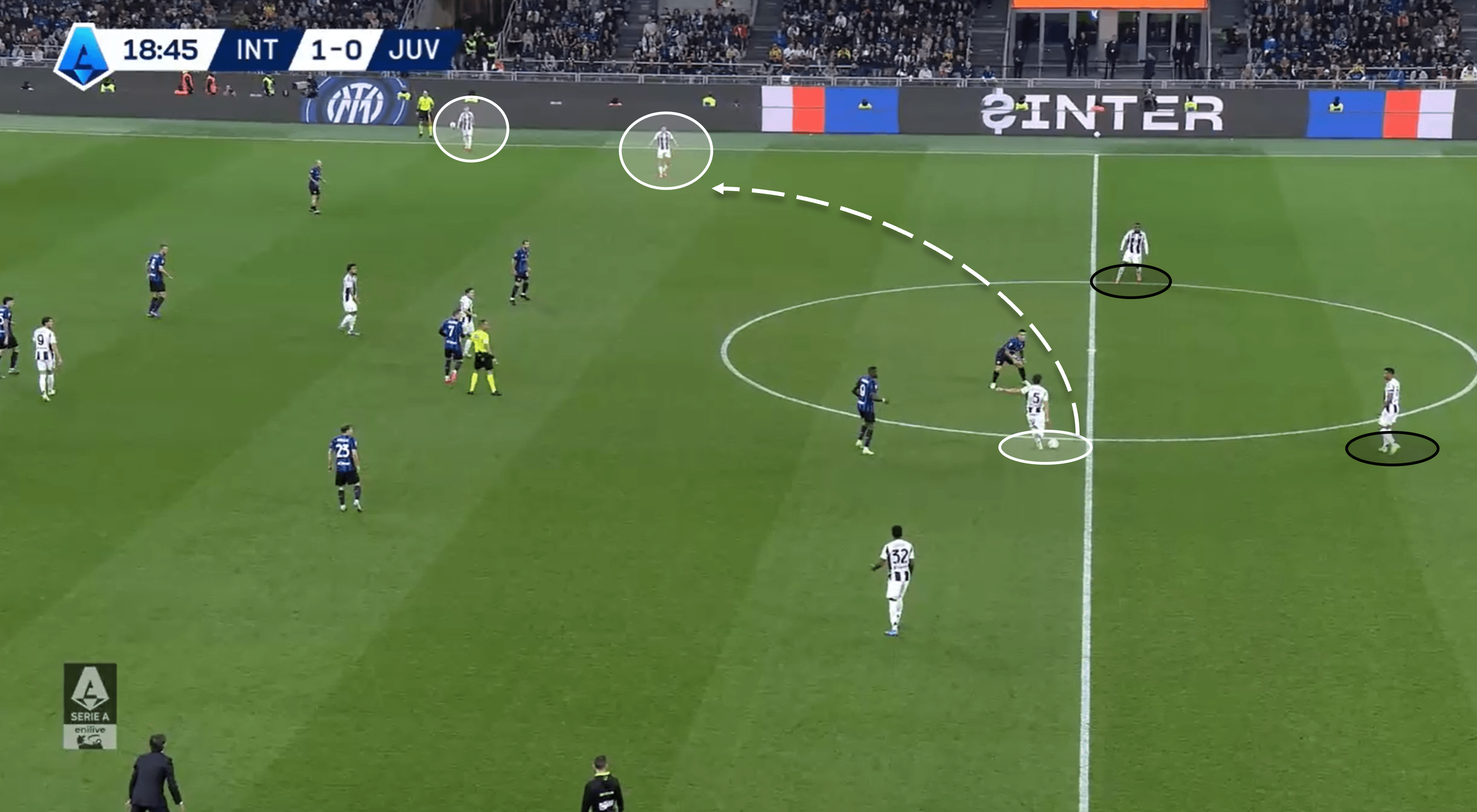
Playing against a mid-block requires one of two things: patience to pass the ball around and eventually find an opening or creativity and directness to exploit spaces the opposition hasn’t marked.
This is where Juve’s wide presence really came in the clutch – they knew having just one wide player on the flank would be ineffective and potentially dangerous in terms of the chances of a turnover if the pass went out to that one winger, so they added a second option to outnumber the Inter full-back ultimately.
Juventus needed a very well-executed curled pass from Locatelli out to the right flank to take full advantage of this.
While it may appear a straightforward move at first from the midfielder, consider this: How many times in similar situations do we see central midfielders pick the easy pass to one of the highlighted Juve CBs instead of taking some attacking responsibility?
These kinds of possession progression can catch the opposition off-guard and remove several individuals from the equation.
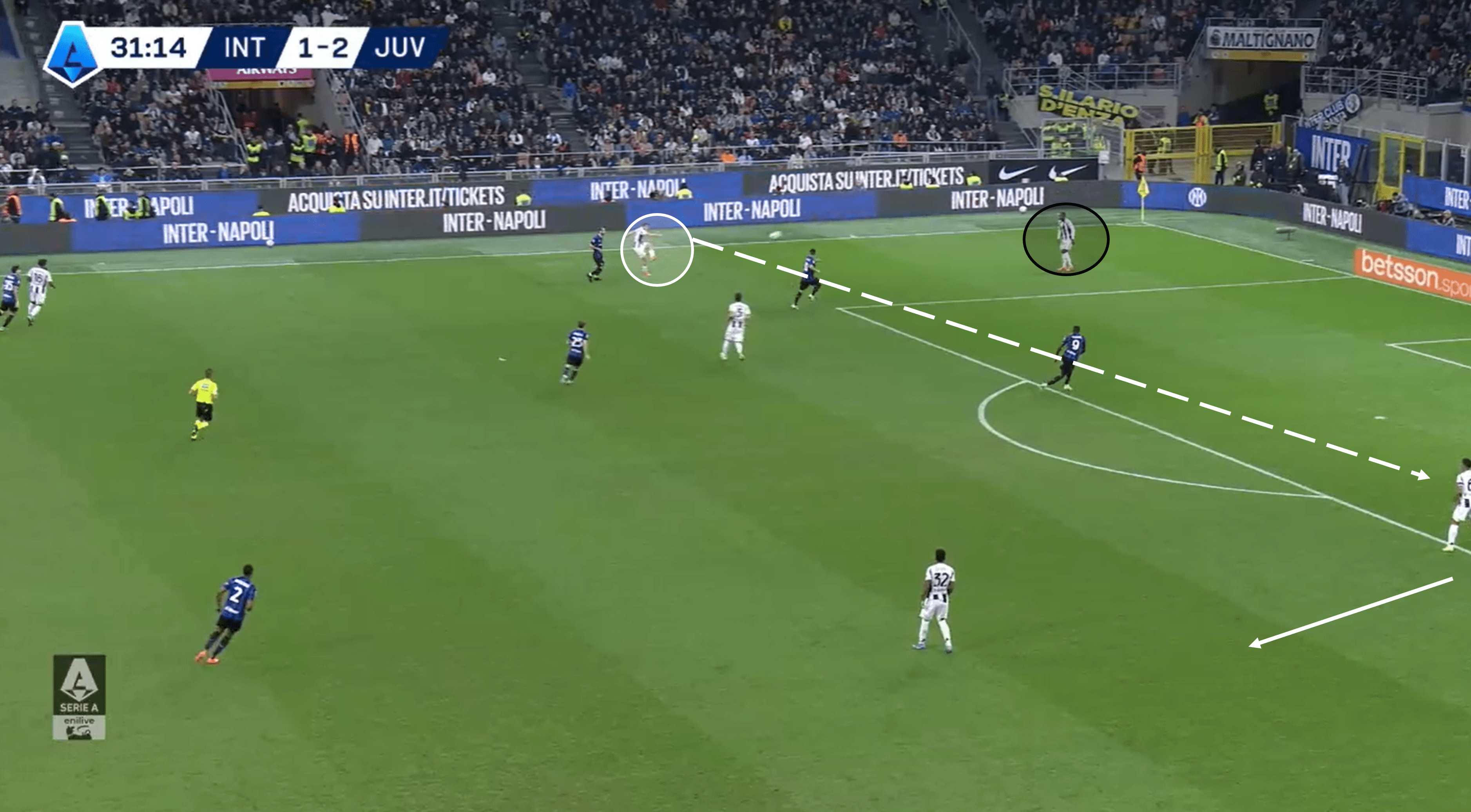
We saw similar passes when Jvue were under pressure from Inter deep in their own half.
Credit here goes to several individuals – the passer, of course, as well as nearby passing options who basically act as decoys.
But perhaps the most impressive element in these tactics is the off-the-ball movement and positioning by the eventual recipients of the ball – so often Juve seemed to have a spare man in a lot of space just waiting to receive the ball and take it forward.
And that’s what centre-back Danilo did in this example – upon receiving the ball, he carried it forward, showing excellent ball progression by driving all the way into the Inter half before releasing the ball to a midfield teammate.
Just like that, with one pass and a progressive run, Juventus transformed deep possession under pressure into a dangerous attack.
Conclusion
In truth, there are several ways of looking at this result.
Did Inter’s two penalties save them from a 4-2 defeat?
Some may look at it that way – but Inter had more shots and a higher xG register, so they did pose an attacking threat (although we did not touch on it in this analysis as we thought their defensive tactics were more thought-provoking).
Juventus will feel somewhat shocked at conceding four goals, given their defensive record before this game – although only one of those four came from open play!
Both sides will have beliefs that they should have won this, no doubt.

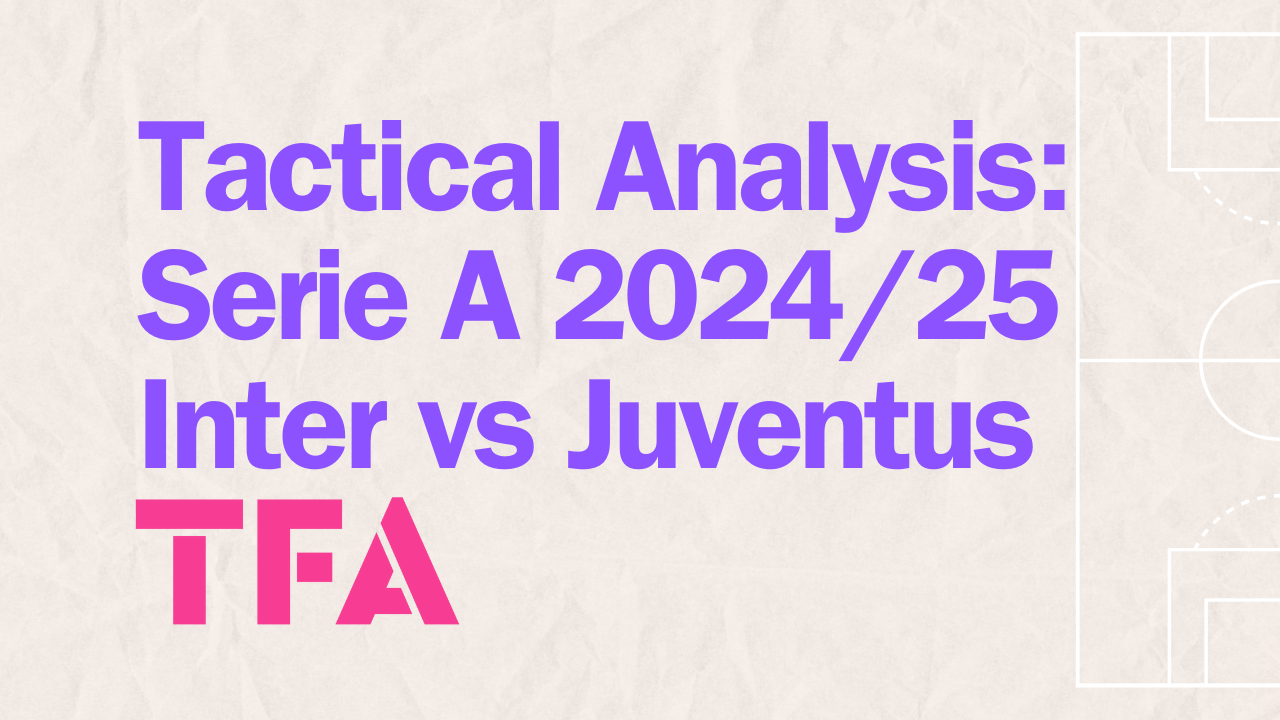




Comments